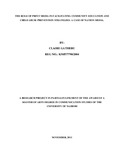| dc.description.abstract | Child abuse is not a new phenomenon, nor is public or state concern about it. Nevertheless fresh attempts to tackle child mistreatment are usually accompanied by the declaration that it is a new and as yet undiscovered problem. This newness is seen as an important part of the process of establishing it as an issue requiring resources to tackle it. This research was therefore motivated to determine the role of print media in facilitating community education and child abuse prevention strategies. The specific objectives of the study were to determine how print media influences community education and child abuse prevention strategies, to determine the benefits of mass media programs as a tool to advocate for children’s rights and to determine different campaign strategies that can be used in child abuse prevention strategies by nation media. This research was a case study. This research problem could best be studied through the use of a descriptive survey. The population of this study comprised of staff members from Nation media (printing department). The researcher used simple random sampling to select 45 respondents from 132 target population. The researcher used primary data (questionnaires) to carry out the study. Data was analyzed using descriptive and inferential statistics. This enabled the researcher to make possible predictions about the study. The descriptive statistical tools helped the researcher to describe the data and determine the extent to be used. The findings were presented using tables and charts. Data analysis used SPSS and Microsoft excel, percentages, tabulations, means and other central tendencies.The study found that child abuse is a common problem in Kenya and print media influences community education and child abuse prevention strategies positively. The study further revealed that the print media leads to increased acceptance of the seriousness of child sexual assault, a higher perception of the prevalence of child sexual assault and a higher awareness of the potential for sexual abuse to be perpetrated by adults known to the child. On the benefits of mass media programs as a tool to advocate for children’s rights the study found that quality children’s magazines can enhance child development by providing positive role models of cooperation and collaboration as a responsible way of acting in the world. | en |

